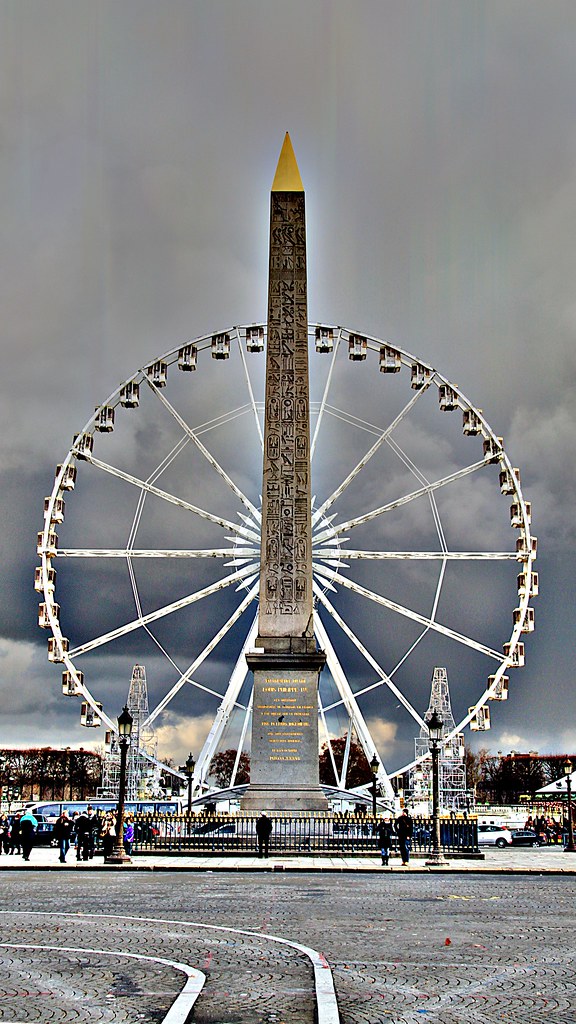
Описание: Ob'elisque et grande roue, Place de la Concorde, peu de temps avant la pluie... L'ob'elisque 'egyptien de Louxor, vieux de 3 300 ans (XIIIe si`ecle av. J.-C.), fut transport'e en France en 1836, offert par l''Egypte en reconnaissance du r^ole du Francais Champollion qui a 'et'e le premier `a traduire les hi'eroglyphes. Le roi Louis-Philippe le fit placer au centre de la place lors son l'am'enagement par l'architecte Hittorff. Haut de 22,86 m`etres, le monolithe, en granite rose de Sy`ene, p`ese 227 tonnes. Il est 'erig'e sur un socle de 9 m`etres et est coiff'e d'un pyramidion dor'e de plus de trois m`etres et demi. Les hi'eroglyphes qui le recouvrent c'el`ebrent la gloire du pharaon Rams`es II. Le sommet de cet ob'elisque est surmont'e d'un pyramidion de plus de 3,50 m, ajout'e en mai 1998, aussi pointu qu''etincelant, fait de bronze et de feuilles d'or. Il est cens'e remplacer un pr'ec'edent ornement sommital, emport'e lors d'invasions en 'Egypte au VIe si`ecle. L'ob'elisque se situe sur la ligne de l'axe historique de Paris qui va de l'Arc de triomphe du Carrousel `a l'Arche de la D'efense en passant par le jardin des Tuileries et l'avenue des Champs-'Elys'ees. L'ob'elisque est aussi un cadran solaire, gr^ace `a des lignes trac'ees au sol. The center of the Place is occupied by a giant Egyptian obelisk decorated with hieroglyphics exalting the reign of the pharaoh Ramses II. It is one of two the Egyptian government gave to the French in the nineteenth century. The other one stayed in Egypt, too difficult and heavy to move to France with the technology at that time. In the 1990s, President Francois Mitterrand gave the second obelisk back to the Egyptians. The obelisk once marked the entrance to the Luxor Temple. The Ottoman viceroy of Egypt, Mehmet Ali, offered the 3,300-year-old Luxor Obelisk to France in 1829. It arrived in Paris on 21 December 1833. Three years later, on 25 October 1836, King Louis Philippe had it placed in the center of Place de la Concorde, where a guillotine used to stand during the Revolution. The obelisk, a red granite column, rises 23 metres (75 ft) high, including the base, and weighs over 250 metric tons (280 short tons). Given the technical limitations of the day, transporting it was no easy feat — on the pedestal are drawn diagrams explaining the machinery that was used for the transportation. The obelisk is flanked on both sides by fountains constructed at the time of its erection on the Place. Early morning on 1 December 1993, the French AIDS fighting society Act Up Paris carried out a fast and unwarned commando-style operation. A giant pink condom was unrolled over the whole monument.[3] Missing its original cap, believed stolen in the 6th century BC, the government of France added a gold-leafed pyramid cap to the top of the obelisk in 1998. Source, Wikipedia
Tags:
Поиск и фотоизображения предоставлены компанией Flickr с помощью сервиса Flickr API согласно Правилам пользования сайтом Flick.com и его сервисами. Графические изображения являются публичными, размещёнными их авторами в свободный доступ (Public) и физически расположены на серверах Flickr. Все права на фотографии принадлежат их авторам согласно пользовательскому соглашению сервиса Flickr.com и охраняются законами, регулирующими авторские права.